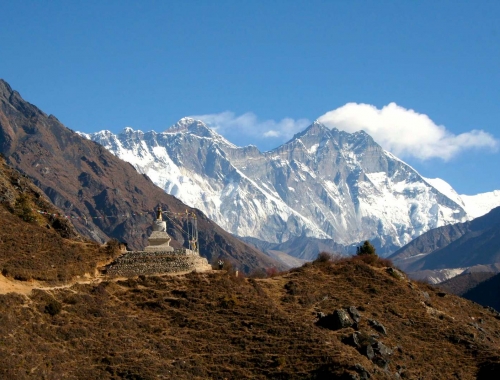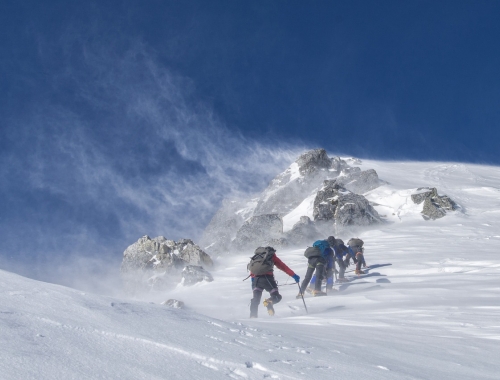Highlights
- One of Nepal's tallest trekking peaks
- The incredible Annapurna Circuit Trekking
- Escorted by one of our knowledgeable Sherpa climbers
- Trekking over the 5,416-meter Thorang La pass
- Breathtaking peak vista of the Annapurna mountains
- Exploration of the marshyangdi valley's natural and cultural landscape and lower Mustang
Trip Fact
- Destination: Nepal
- Trip Grade: MODERATE TO STRENUOUS
- Activities: PEAK CLIMBING
- Altitude: Chulu West Peak (6,420m)
- Best season: Autumn & Spring
- Transportation: Car/Van, Flight
- Accomodation: Hotel/Teahouse/Tented Camp
- Min Pack: 1 person
Trip Itinerary
After clearing customs and immigration at Kathmandu's Tribhuvan International Airport, a representative will be waiting to welcome you at the arrival exit and accompany you to the hotel of your choice.
The remaining hour can be spent lounging in your hotel room or exploring Thamel's streets on foot. An excellent Nepali restaurant will hold a welcome dinner in the evening where you can enjoy traditional Nepalese food and take in a cultural performance.
UNESCO World Heritage Sites including Boudhanath, Pasupatinath, and Moneky Temple will be among the places you will visit today. Following a brief detour, you'll be driven to your accommodation.
You'll attend a meeting and discuss your peak-climbing experience there. You will have the chance to discuss the equipment required for peak climbing when you first meet your guide and the other trekkers. You can visit the Thamel Bazar later in the evening to get your essentials.
You will leave Kathmandu early this morning to travel to Dharapani. After diverging from the Pokhara highway and heading north alongside the Marshyangdi River, the route takes us west while following the Trisuli River. Typically, you will land in Besisahar in the early afternoon and go to Dharapani in a private jeep. All day long, you'll follow the Marshyangdi Valley.
Today, you will depart Dharapani. Since you are gradually climbing to higher heights, the walk today has primarily been uphill. After passing through several schools and climbing a hill from Dharapani, the trail falls to Bagarchhap after an hour of hiking.
You can visit this village to experience Tibetan culture, which includes a monastery, a gompa ornamented with prayer wheels, and structures that symbolize Buddhist culture. You will arrive at another Tibetan town, Danakyu, after continuing through the constrained forested ravine and past the waterfall's view.
To get to Chame, you will continue through a region with lush forests, cross tiny rivers, hike past waterfalls, cross steep stones, and pass through a few Tibetan communities like Thanchow and Koto. The Manang district's administrative center is located in Chame. You may enjoy a beautiful view of mountains along the way, including Annapurna II and a few other peaks in the Annapurna range.
Every day as you hike, you gain altitude, and as you do, you can sense how the terrain, plants, and way of life change. Today’s journey takes us to the lovely village of Pisang, which serves as the starting point for ascending the Pisang Peak.
The trip offers vistas of alpine summits starting at Chame. As you continue on the trail, you can take in the views of Annapurna II and Manaslu from Chame and Annapurna IV and Lamjung Himal.
You are currently in the Nyesyang region of Manang, which is dry and barren. This region is located in a rain shadow region of the Himalayas, where it rarely rains during the summer but snows during the winter. Most residents in the area are farmers and traders.
There are two ways to go to the Manang Valley from Pisang. You will choose the route that parallels the valley floor's left bank. You will get spectacular views of Tilicho, Gangapurna, Annapurna III, and IV today.
After crossing the river at Hungde, you will continue on a pretty wide path through buckwheat and potato fields to the village of Braga, which is renowned for its monastery and is thought to be more than 500 years old. The village of Manang will thereafter be reached after a little ascent.
Today you will acclimate at Manang to assist your body to adjust to the decreased oxygen levels brought on by the rise in altitude. On this day, you will take a few quick excursions around the valley to higher elevations. Your body will adjust to the challenging Chulu West Peak's quick ascent throughout the next couple of days during this day of acclimatization.
The Bhojo Gompa, Gaganpurna Lake, the modest and historic monastery at Braga, and the office of the Himalayan Rescue Association—where you can learn more about altitude sickness—are the places to visit on a day trip near Manang. You will benefit from acclimatization if you have already hiked the Upper Pisang path.
The trail ascends sharply to the last permanent town, Tenki, after passing through Manang. The trail briefly ascends to Gunsang, a little community of tea houses with a breathtaking mountain outlook.
Then you will ascend to Yak Kharka, the settlement with open pasture grounds for the yaks, through the trail with Mani walls and little tea shops. On a hike with a moderate elevation, you will arrive at Ledar, by crossing another glacier stream and passing through landslide-prone terrain. You will spend the night in Ledder which is surrounded by flora and alpine trees.
In a few days, you will be getting ready for the climb up Chulu West Peak. The base camp of Chulu West Peak will be the trek's destination today. Although the climb to base camp is not technically difficult, the elevation makes it quite exhausting.
You will reach the breathtaking panorama of the base camp by moving carefully along the rocky trail. The Annapurna massifs are magnificent from Chulu West Base Camp. You'll pitch your tent in base camp to enjoy the magnificent sunset over the Annapurna range as you call it a day.
As you ascend from Base Camp, the elevation on the Chulu West slopes keeps going. Although the climb to High Camp is not particularly challenging, the slope's rocky and icy surface may need the use of crampons, ropes, and ice axes.
As other climbers get ready to spend the night in the High Camp, the crew's skilled members mend the ropes in the steep and challenging portions. Although some climbers attempt to summit starting from the Base Camp, staying in the High Camp allows the climbers to make a reasonably gradual ascent to the peak and aids in acclimatization.
Today is going to be your most daring day since you're going to climb Chulu West Peak. You will begin early, around dawn, on this long, arduous, yet rewarding day. You will ascend gently and carefully on this icy trail and take in the breathtaking views of the Himalayas.
During the ascent, the use of ropes, crampons, and an ice axe are required. Once you reach the summit, you will experience feelings, unlike anything you have ever experienced before. The feeling of joy and triumph, accomplishment and success combined with the magnificent and expansive view of the mountains will forever remain in your mind and memory.
The view of the Annapurna II, Annapurna IV, Gaganpurna Peak, and Lamjung Peak, is exceptional. Once you have captured these lovely moments, you'll gently make your way back to base camp.
We have added an extra day to the plan because we cannot guarantee that the summit day will be sunny and warm. The reserve day would be helpful if you are unable to summit the Chulu West Peak on the scheduled day due to adverse weather or another factor, such as a member of the group experiencing acclimatization issues.
You will start heading towards Phedi after your breakfast. You will keep going through fields until you reach a town named Letdar, from where you have a beautiful view of Chulu West.
From there, the trail ascends the scree slopes high above the river to Phedi before turning off to follow the bank of the Jarsang Khola, a tributary of Marsyangdi. You will spend the rest of the day in Phedi.
You must rise early today to cross Thorung La Pass (5416 m). As soon as you leave camp, the trail steepens; the path is marked. After almost four hours of steady ascent, the gradient flattens.
The view is amazing from Thorung La Pass, which is maybe the biggest pass in the entire world. Trekkers can see the stunning valleys and gorge created by the raging Kali Gandaki River, the spectacular peaks of the Annapurna range, and the distant snow-capped peaks of Tibet.
You must carefully and gradually descend from the pass after spending some time at its summit. Although the trail from the pass begins gently, it quickly becomes steep and tortuous until it reaches the grassy slopes at the foothills of the difficult climb. The trail takes us past the remains of Yak Herder's Nest and the slopes of the pass to the community of Chaharu before continuing to the sacred destination of Muktinath.
Day15: Trekking from Muktinath to Jomsom (2,750m) / 5-6 hours
Before reaching Jomson, you will pass through the village of Kagbeni as you go through the Kali Gandaki Gorge. You will follow the Kali Gandaki River trails today as you go to Jomsom after walking through the windy and barren Kagbeni region.
Kagbeni, which is located in the Kali Gandaki valley, was originally one of the main trading routes connecting Tibet and India, as evidenced by the arrangement of the homes, which is fortified. The trail travels through various bustling communities, including Ekle Bhatti, as well as the village's ruins as it follows the Kali Gandaki River.
The route from Ekle Bhatti to Jomsom is a simple one that leads hikers past historic gompas, sand beaches created by the river, and other cultural landmarks as well as alongside the road that connects Jomsom with higher regions, such as Muktinath. You'll spend the night in Jomsom and explore this tranquil town while learning more about the local Tibetan culture and customs.
The flight from Jomsom to Pokhara departs early in the day since the weather makes it difficult for the flight to take off in the afternoon. You will be flying above the varied landscapes, above the deepest gorge and the lush valley produced by the Kali Gandaki River,
You can enjoy spectacular views of shimmering mountains, including the Annapurna massifs. Then you will arrive at Pokhara, a picturesque city and the unofficial tourism hub of Nepal. You will get started on the journey around the Pokhara valley after relaxing. There are several tourist attractions in this Lake City.
There are many places to visit, varying from the well-known Phewa Lake—where, on clear days, you can see Fishtail Mountain reflected in the lake—to the quiet Devis Falls, from the Mahendra Cave, which was named for a former king of the Shah dynasty, to the Gupteshwor Mahadev cave, which residences a shrine to Lord Shiva.
You will leave the lovely Pokhara valley and travel to Kathmandu on the last day of your thrilling journey. Starting early from this picturesque city, you will travel through rural villages, landscapes, winding roads, green hills, small but lovely waterfalls, and religious sites like Manakamana Temple.
You can also take a direct flight to Kathmandu airport. The fare depends upon the season and the airline that you travel by. Once you reach Kathmandu, you can relax in your hotel or leave for a cultural and historical adventure.
Today marks the conclusion of the thrilling, exhilarating, and adventurous Chulu West Peak Climbing. You will receive assistance from our agent by being escorted to the international airport. We hope you got the most out of your experience and that you generated memories that will last for a long time.









